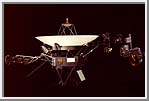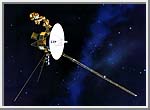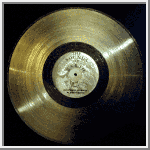
Table of Contents
- Voyager Spacecraft Introduction (This Page)
- The Voyager Planetary Mission
- Voyager Project Home Page
The twin Voyager spacecraft, over the course of a dozen years, drew back the curtain on nearly half of the solar system. From launch in 1977 through the spectacular parting shots in 1989 of Neptune at the outer reaches of the solar system, this pair of gangly, instrument-laden spacecraft explored four planets -- Jupiter, Saturn, Uranus and Neptune -- as well as tens of moons, and the rings and magnetic environments of those planetary systems.
The Voyagers were designed to take advantage of a rare geometric arrangement of the outer planets that occurs only once every 176 years. This configuration allows a spacecraft to swing from one planet to the next without the need for large onboard propulsion systems; the flyby of each planet both accelerates the spacecraft and bends its flight path. Without this gravity assist, the flight time to Neptune would be 30 years.
Voyager 2 was launched first, on August 20, 1977, followed by Voyager 1, which was put on a faster, shorter trajectory to Jupiter on September 5, 1977. Both launches took place at the Cape Canaveral Air Force Station in Florida. Eighteen months after launch, Voyager 1 reached Jupiter, 650 million kilometers (400 million miles) away. The spacecraft made its closest approach on March 5, 1979, while Voyager 2 followed on July 9 of the same year. Images streaming back from the pair of spacecraft began to show the complicated, swirling turbulence of Jupiter's atmosphere in exquisite detail. A giant storm three times the size of Earth was raging in Jupiter's upper atmosphere, surrounded by rippling currents that rotated around it. Voyager 1 made a startling discovery; it found nine active volcanoes erupting on Io, the innermost of Jupiter's four major moons. Four months later, Voyager 2 found that eight of the nine volcanoes were still erupting. Much to everyone's surprise, a thin, dusty ring was also discovered around Jupiter, forcing scientists to revise their thinking on the origins and mechanics of planetary ring systems.
At Saturn, with its majestic rings, the Voyagers took high-resolution pictures to help scientists determine what the rings were made of and what kept them in orbit. Theories to explain planetary rings were being rewritten as fast as the images came down in November 1980 and August 1981, when Voyager 1 and 2, respectively, paid their visits to the gaseous giant.
Saturn was the last planetary encounter for Voyager 1. Project controllers sent Voyager 1 on a trajectory that took it very close to Saturn's large moon Titan. That trajectory bent the spacecraft's path inexorably northward out of the ecliptic plane -- the plane in which most of the planets orbit the Sun. However, JPL scientists and engineers were confident enough in Voyager 2 to send the aging probe on to Uranus and Neptune.
At Uranus, the spacecraft photographed a world oddly tipped on its side, perhaps the result of a colossal primordial collision. Ten new moons were discovered in the Uranus system and the planet's magnetic field turned out to be nearly parallel to Uranus's axis of rotation.
In August 1989, two and a half million kilometers (1.24 million miles) beyond Uranus, Voyager 2 sailed past Neptune, showing off the planet's surprisingly active atmosphere for the first time. Because the planet receives so little sunlight, scientists had expected to see a placid, featureless planet; instead, Voyager showed them a dynamic atmosphere with winds blowing westward, opposite the direction of rotation, at speeds faster than the winds of any other planet. Neptune revealed its Great Dark Spot for the first time, a storm system that resembled Jupiter's Great Red Spot, and a smaller, eastwardly moving cloud, called a "scooter," which was circling the planet about every 16 hours. The blue planet was encircled in diffuse, dusty rings and six new moons were discovered orbiting along with the two that were already known, Nereid and Triton.
As Voyager 2 passed Neptune and began its journey to the edge of the solar system, its camera was rotated to look back at the planets and take one last parting shot of the solar system. Voyager 2's "family portrait" illustrates the vastness of the solar system and the huge expanses of emptiness that lie between the outer planets. Both Voyagers are now headed for the outer boundary of the solar system, where the Sun no longer influences interplanetary space. That edge is thought to be somewhere between 8 billion and 23 billion kilometers (5 billion and 14 billion miles) beyond the Sun. Engineers are optimistic that the Voyagers will still be transmitting data when that boundary is encountered sometime in the first quarter of the 21st century.
 Voyager Spacecraft Model
Voyager Spacecraft Model
Twin Voyager spacecraft, depicted here in a full-scale model, are
now traveling through the outer solar system. Voyager 1 has
completed its mission to Jupiter and Saturn and is now outbound
from the solar system. Voyager 2 followed its sister craft to
Jupiter and Saturn followed by encounters with Uranus and Neptune.
In this view, the
science boom, containing cameras and other instruments requiring
pointing, is seen at right. The dominant feature at center, the
12-foot-diameter high-gain antenna, provides communication
between the spacecraft and controllers on Earth. Just below is a
shiny gold disk, a record called "Sounds of Earth," bearing
messages and pictures from our planet.
(Courtesy Calvin J. Hamilton/NASA)
 Voyager Spacecraft
Voyager Spacecraft
This image shows another view of a full-scale model of one of
the Voyager spacecraft sent to explore the giant outer planets in
our solar system.
(Courtesy NASA)
 Voyager liftoff in Titan-Centaur
Voyager liftoff in Titan-Centaur
This image shows the 1977 launch of one of the Voyager spacecrafts.
From the NASA Kennedy Space Center at Cape Canaveral, Florida, Voyager
2 was launched first, on August 20, 1977; Voyager 1 was launched on a
faster, shorter trajectory on September 5, 1977.
Both Voyagers continue to explore interstellar space.
They were delivered to space aboard Titan-Centaur expendable rockets.
(Courtesy NASA)
 The Sounds of Earth
The Sounds of Earth
On the chance that someone is out there, NASA approved the placement of
a phonograph record on each of the Voyager spacecraft. The recording,
called "Sounds of Earth" fits on a 12-inch, copper disc
containing greetings from Earth people in 60 languages, samples of music
from different cultures and eras, and natural sounds of surf, wind and
thunder, and birds, whales and other animals.
The record also contains electronic information that an advanced
technological civilization could convert into diagrams, pictures
and printed words, including a message from President Carter.
(Courtesy NASA)